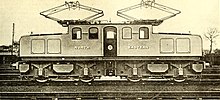Midi E 4000
| Midi E 4000 | |
|---|---|
|
E 4002 in the Mulhouse Railway Museum (Cité du Train)
|
|
| Numbering: | E 4001–4040 ( Midi ) BB 1521–1540 ( SNCF ) BB 1631–1650 (SNCF) |
| Number: | 40 |
| Manufacturer: | CEF |
| Year of construction (s): | 1923-1926 |
| Retirement: | 1984 |
| Axis formula : | Bo'Bo ' |
| Gauge : | 1435 mm ( standard gauge ) |
| Length over buffers: | 11,850 mm |
| Service mass: | 76 t |
| Top speed: | 60 km / h |
| Continuous output : | 680 kW |
| Number of traction motors: | 4 × type Dick-Kerr DK 80 |
| Drive: | electrical, 1500 V = |
The locomotives of the E 4000 series were standard-gauge electric locomotives of the French railway company Compagnie des chemins de fer du Midi ( Midi ). They were almost identical to the 50 machines in the E 4500 series ; they only differed from them in terms of a different gear ratio and the lack of a regenerative brake . In 1938 they were taken over with new operating numbers by the state railway SNCF founded that year .
prehistory
The Midi was the only one of the large French railway companies whose tracks did not lead to the capital Paris . Their stretches lay south of the Massif Central between the Atlantic and the Mediterranean and led far into the northern Pyrenees . Since the coalfields were far away in the north of France, the fuel for the operation of the steam locomotives had to be procured from other companies over long distances. Therefore, as early as 1909, an extensive electrification program was developed using the hydropower available in the Pyrenees .
A power supply by means of an overhead line with an alternating voltage of 12 kV and a frequency of 16 2⁄3 Hz was chosen. Between 1912 and 1914, electrical operation was started on four routes.
The extreme shortage of coal during the First World War - the most important coalfields were occupied by German troops - prompted the government to decide to electrify additional railway lines. While those on the northern and eastern French routes were rejected for strategic military reasons, the electrification of railways in the southern half of France and in the greater Paris area with 1500 V DC was advocated . To standardize electrification in the country, the use of this voltage was made mandatory on August 29, 1920. This was to ensure that the locomotives could be used across networks in the event of another defense. The Midi then switched three of its already electrified routes to the prescribed electricity system.
History and description
Since no corresponding machines from local production had been developed, a group of Midi engineers looked around in Great Britain in 1918 . The North Eastern Railway ran ten four-axle bogie locomotives (later the EF 1 series ) with engines from Dick, Kerr & Co. , which they used as the basis for their own development. The Constructions électriques de France (CEF) company received the order to build 20 corresponding machines, Dick-Kerr himself supplied the plans and some of the motors. While the E 4001–4004 received original Dick Kerr engines, those of the other locomotives were manufactured under license . The series E 4000 (for freight trains) and E 4500 (for passenger traffic) differed only in the gear ratio and the regenerative brake. Unlike the British, the French locomotives but recognized - US -Konstruktionsprinzipien accordingly - a Boxcab - locomotive body with two Endführerständen on.
At the end of 1925 the electrified network of the Midi had exceeded the route length of 400 km. The British engines had proven to be unsuitable for the topography of the Midi. They were not arranged optimally and tended to overheat, the contactors of the cam switch mechanism were not able to cope with the loads. Therefore the power of the locomotives had to be reduced from approx. 1000 kW to almost 700 kW. The 20 machines of the second series (E 4021–4040), which were delivered in 1926, had therefore been fundamentally revised in the electrical part.
The SNCF included the locomotives in their numbering scheme after they were taken over in 1938. So the E 4001–4020 initially became the E 4531–4550, later these machines were redesignated as BB 1631–1650. The locomotives of the second series were assigned to the BB 1500 series. Together with its sister series E 4500, the E 4000 were converted into shunting locomotives after the Second World War .
Storage and whereabouts
The first machines were taken out of service in 1971. On December 15, 1984, the BB 1613 of the Chambéry depot , a former E 4500, was the last locomotive of this type to be parked. With the E 4002 (later BB 1632) an E 4000 was preserved in the Cité du Train .
Remarks
- ↑ The former E 4501–4530 became BB 1601–1630
Individual evidence
- ↑ a b c d BB 900, BB 4200 & BB 4700 in: Ferrovissime No. 11., p. 33 ff.
- ↑ Didier Janssoone: L'Histoire des chemins de fer pour les nuls , p. 64 ff.
- ↑ a b Thomas Estler: Locomotives of the French state railway SNCF . 1st edition. Transpress, Stuttgart 2014, ISBN 978-3-613-71480-9 , pp. 34 .

